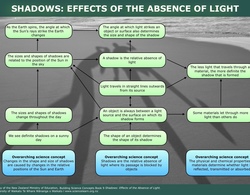
Shadows vary in intensity – how definite they appear. This depends on:
- the intensity of the light source and how strong the contrast between the shadow and the lit surface seems to be, which can be very subjective
- the transparency of the object – how much light it lets through
- whether there is any other material or light source between the main light source and the object, for example, clouds or smoke.
A small source of light (for example, a small spotlight) forms a dark shadow with sharply defined edges. A physically large source of light casts a shadow that is dark in the centre but lighter and fuzzier around the outside. One reason for the blurring can be the size of the source – the larger the source, the larger the number of directions from which light can come, forming many overlapping shadows, each slightly different. You can see examples of this in the shadows formed by a fluorescent light. Diffraction (light’s capacity to bend) is another reason for shadows to lighten and blur around the edges.
Both of these effects can be increased or lessened by the object’s distance from the surface on which its shadow forms. The closer the object is to the surface, the darker and more definite its shadow becomes. The darkest part of a shadow is called the umbra, and the blurred, lighter parts at the edge are called the penumbra.
Related article
Related images
Related activities
IMAGE: Gabriele Maria Gral, licensed through 123RF Ltd


